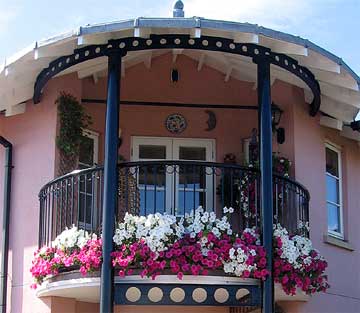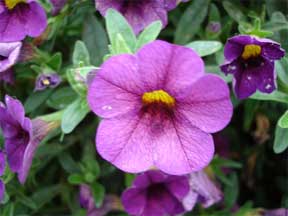If you are a recent or even brand new gardener you can plant a garden this spring you will later be proud of if you concentrate on foolproof annuals. You can have the fun of selecting annuals from catalogs, then sowing the seed, and in a pinch you can go to your nearest nursery or greenhouse and buy dozens of young plants of petunias, marigolds or zinnias just about ready to start flowering. You will spend barely a dollar or under for seed packets and only a few dollars more for plants—all in all, a bargain!
If you are a seasoned gardener, perhaps this is the spring when you should take a fresh look at the opportunities and challenges presented by annuals. For there are better and stronger varieties, a wider range of colors, and hybridizers have worked to make some slow-to—bloom annuals produce their flowers earlier.
Experiment with Plantings

Petunias are redder, zinnias come in a greater selection of lovely pastels, snapdragons and cosmos are quicker to bloom from seed and marigolds (thank goodness!) are getting paler and paler. If color is your particular interest, experiment with plantings of some of these new as well as tried annuals. If you are challenged by the problem of combining plant forms and textures, design and plant a garden of annuals. For they can be used in a long, narrow border, a wide, bursting one, a dooryard or terrace grouping, or in any way your conditions dictate. They are as versatile a group of plants as you will want.
It is no exaggeration to say that most annuals are foolproof. There are annuals that you can sow in the open ground which will grow rapidly, soon be in flower and continue to bloom until blackened by heavy frosts in the fall. (Annuals are those plants which make their growth and produce their flowers in one season, then die. Perennials, on the other hand, are plants which live on year after year, new growth appearing from the roots each spring.)
Foolproof Annuals
Among the foolproof annuals and certainly those to consider if you are planting your first garden are sweet alyssum, zinnia, marigold, nasturtium (nasturtium may get buggy look for clusters of black aphids on leaves and stalks-but an all-purpose spray or dust applied every ten days or so will control them), cosmos, cleome, morning glory, nicotiana (flowering tobacco), and celosia.
All of these can be started from seed which can be sown in a special seed hed then transplanted, or they can be sown directly in designated locations where they will later flower. In either case, the young seedlings should be thinned so that each plant is from 6 to 8 inches from its neighbor. An exception to this would be sweet alyssum; it doesn’t mind crowding and the closer the plants are, the sooner you will have the carpet of white or violet that makes this annual so valuable for edging.
The nine annuals just listed have the forms, varying heights and colors to make a garden in themselves. All that is needed is a selection of tall African marigolds, tall giant zinnias, cleome and cosmos for the background.
The middle section can include nicotiana, celosia, lower-growing zinnias and marigolds and the front section, nasturtium, dwarf marigolds and zinnias and sweet alyssum.
Morning glories, which climb, can be part of this garden, if you plant them next to posts set every 6 feet or so, depending on the length of the border. Or if a fence is the background for the garden, plant morning glories along it.
Nine Basic Annuals
As for color, these nine basic annuals give just about every color variant you’ll need. Selecting annuals for color from seed catalogs is part of the fun of seed packet gardening. You may hear or read that color isn’t important when you plant annuals that they are all so bright and cheerful that any combination is bound to be pleasing. This is only partially true you’ll soon discover that bright oranges and pale pinks don’t enhance each other in the garden any more than they do in your living room or in dress fabrics.
You will also find that you will get the best results when you plant each kind of annual in a large bed or block. For instance, plant zinnias in groups of eight plants or more of the same color and variety. (Occasionally, you’ll want to include one variety that is a mixture of pastels.)
While the annuals just mentioned will result in an attractive garden in themselves, beginner and experienced gardeners alike will want to grow petunias and snapdragons. Both, once they have started flowering, will bloom on week after week, giving an abundance of flowers for both garden display and cutting.
For the earliest bloom, petunias and snapdragons should be started indoors, but if you are patient, you can sow seeds outdoors in a seed bed, thin the little plants as they crowd each other and finally transplant the young plants into the sections where they are to flower. In comparison with zinnias, marigolds and other annuals, petunias and snapdragons grow slowly at first, and you wonder if they ever will reach flowering size. Suddenly, though, they do, and the gardener who has nursed them along from seed to flower has something to be really proud of.
And don’t forget that you can still have petunias, snapdragons, ageratum, nierembergia, verbena, annual hollyhocks. vinca, and other annuals even if you miss sowing them from seed yourself. You can buy plants up to early summer at most garden centers, nurseries and greenhouses. The only hitch is that you will have to select the varieties that are available.
Quite the opposite from petunias and snapdragons and other annuals which need a moderately long growing season before beginning to flower are a number of quick growers. They grow as fast as marigolds and zinnias and sweet alyssum and others of our nine basic annuals, but have one disadvantage: they tend to bloom themselves to death in a few weeks, leaving a gap in the garden as the summer progresses. This lack is of no matter in the cutting garden, but unless you have a supply of young plants that can be moved in as the earlier plantings fade, your garden display will suffer. Fortunately it’s quite feasible to have a nursery bed of extra annual plants to be used as fill-ins.
Annuals Without a Full Color Season
Annuals that are well worth growing but which won’t give you a full season of bloom include bachelor buttons or cornflower (centaurea), annual gypsophila or baby’s-breath, larkspur, most annual poppies, and annual phlox. (Moist, cool climates may prolong the blooming periods of some of these.)

Annuals in general demand full sun, average but not over-rich soil. There are a few which can be planted in light shade and which will make a good showing even when they receive only a few hours of filtered sunshine a day. Those tolerant of light shade include balsam, petunia, nierembergia, ageratum, coleus and lobelia.
And finally, here are a few annuals that are sure-fire but are nevertheless not as widely grown as marigolds, zinnias and petunias. A couple require a little more fussing, although hardly any more than is required when petunias are grown from seed.
Salvia farinacea is an aristocrat among annuals. It has long graceful spikes of deep blue flowers. Three or four plants of it placed in a border to contrast with masses of zinnias and marigolds will create a pleasing effect all summer.
The annual periwinkle (Vince rosea) is a plant that the most exacting gardener can admire. Its foliage, glossy and neatly veined, has a crispness not shared by all annuals. Its flowers, which can be pure white, rose or pink or white with a rose eye, are abundant.
Sanvitalia procumbens is called the creeping zinnia it has zinnia-like foliage and small bright-yellow zinnia-like flowers on spreading plants that don’t grow over 6 inches high. It needs plenty of sun, doesn’t mind sandy soil and can get along on only moderate moisture.
